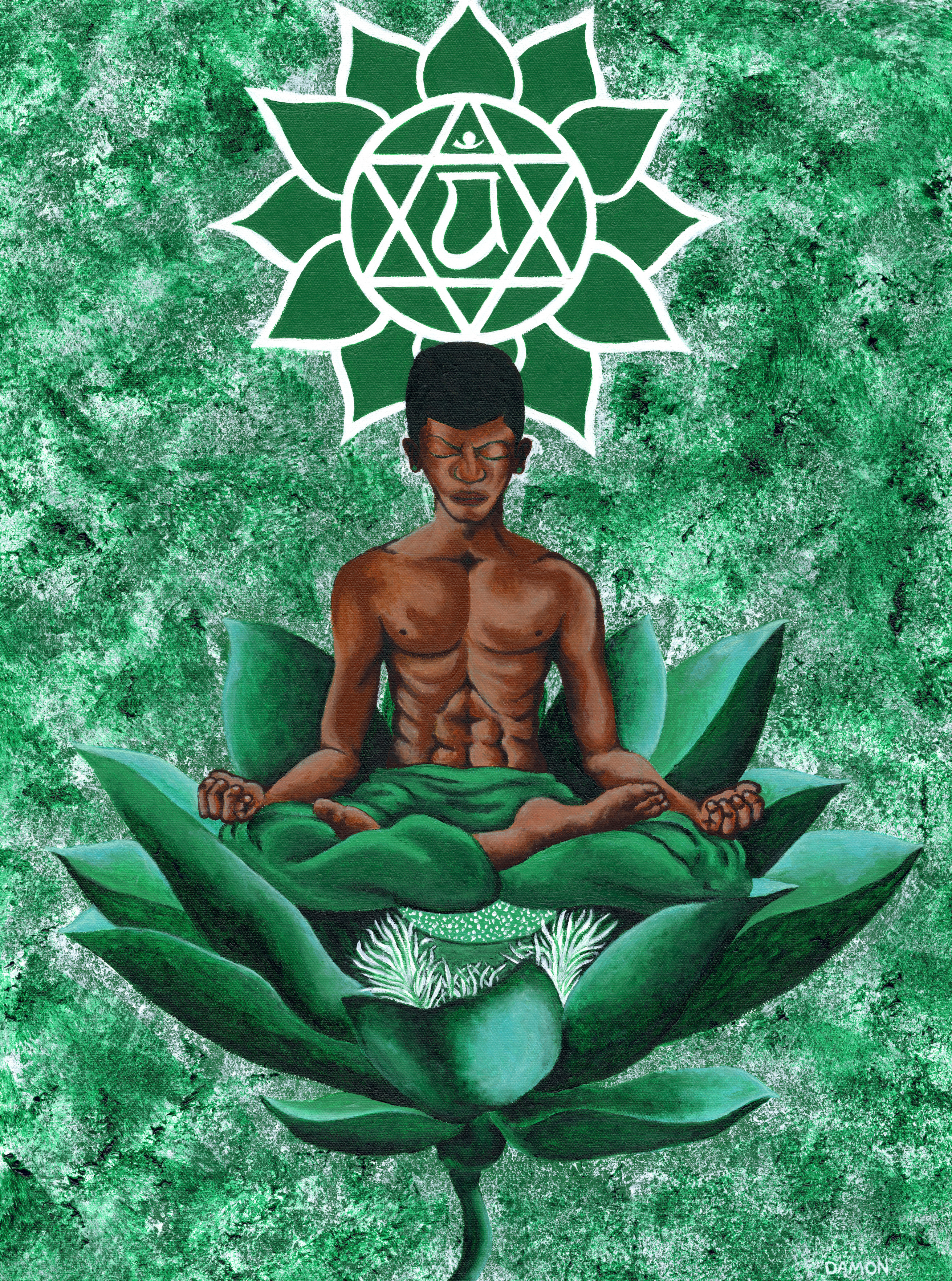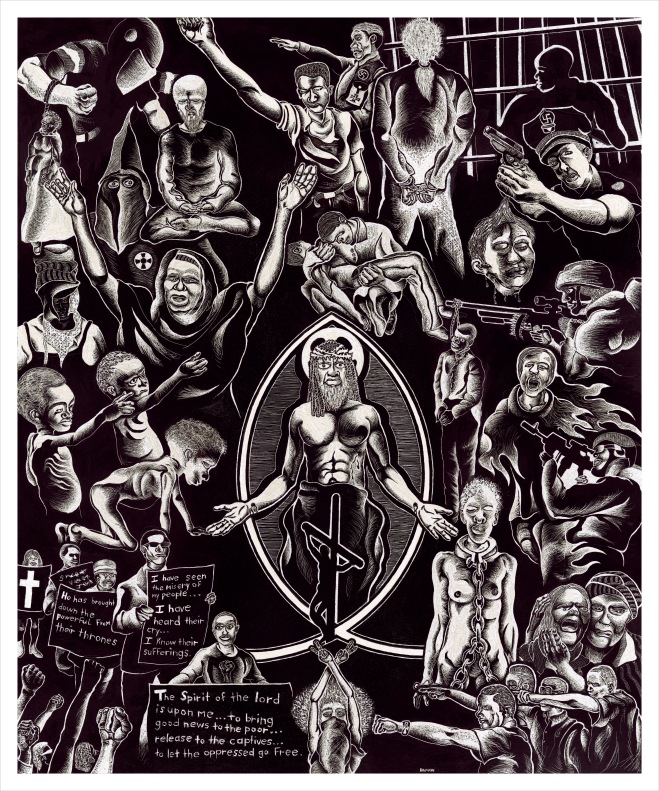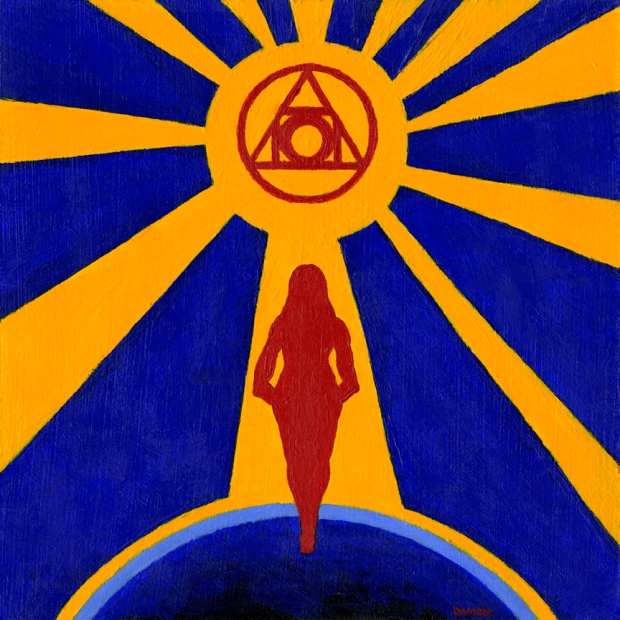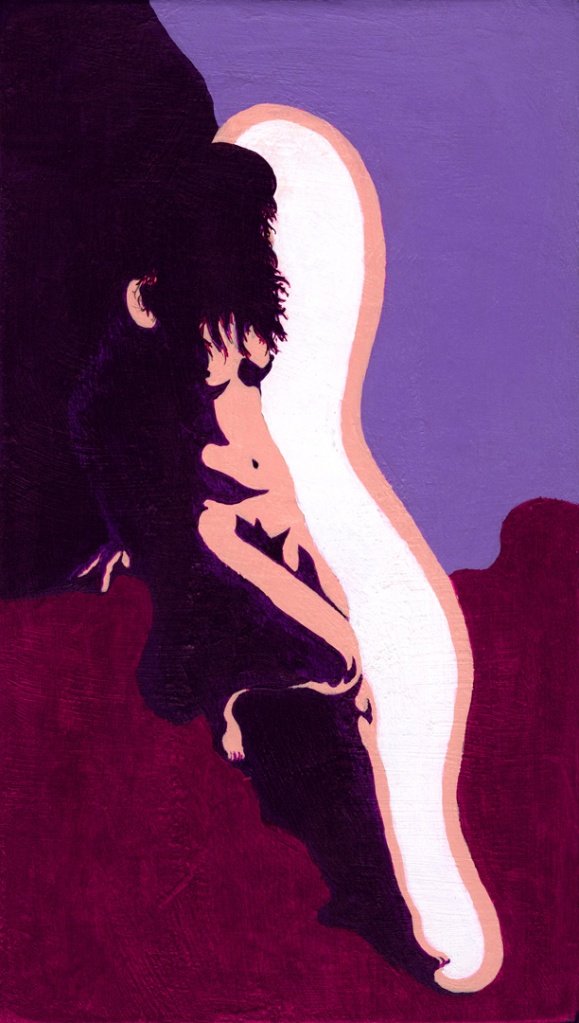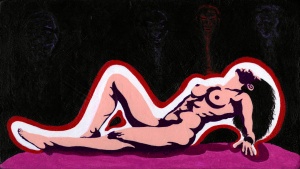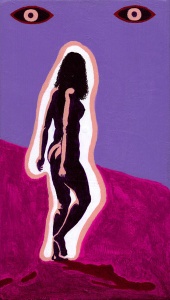Greetings,
As promised I am posting my first blog in order to provide specific details regarding the inspiration and symbolism found within my creations. While I was pondering what imagery to explore during this initial posting, this tryptic came to mind because it too is symbolic of beginnings. It represents my first attempt at combining the insights I was gleaning through my theological studies and spiritual practice, with my training as an artist.
These pieces were initially presented in 2004 as part of a 30-page comprehensive examination which detailed the sources and theological underpinnings of the works. To my surprise, one of the professors on my Examination Committee, the Reverend Dr. George Cummings, Pastor of Imani Community Church expressed his desire to purchase the pieces from me shortly after the exam was completed. Luckily, I was able to get the images digitized before the sale. I am still humbled by the interest he expressed in my efforts and am eternally grateful for his support.
INSPIRATION
The images which comprise this tryptic were inspired by reflections upon the creation narrative found in the biblical book of Genesis, chapter 1. One of my earliest memories of captivation by a work of art is connected to viewing a large picture book that contained images of Michelangelo’s “Creation of Man” painting in the Sistine Chapel. I was touched by the image’s detailed beauty and its spiritual power. When reading the Genesis narrative I would often have flashes of the Sistine Chapel imagery flash into my head.
But as I entered seminary and went on to doctoral studies my memories of Michelangelo’s images became more disconcerting. This memory was embedded within my mind, but it no longer spoke to me in a manner which was comforting or relevant given my place in a postmodern world. All of life is about relations, and our relationship with the world is one of the primary building blocks for all other forms of relation. How we relate to the world determines how we relate to God, self, others, and the rest of creation. Given my place in the world as a black man, the image of a bearded white male passing the energy of life to another white male was creating obstacles which hindered my relationship to the divine and human history. I decided, no I needed to re-contextualize, reinterpret and re-create the creation story into a form that was more life-sustaining for myself and others like me. This meant going beyond merely putting the same events into a contemporary setting, or blackenizing traditional compositions. It meant attempting to create new images and symbols which could speak on their own by fostering a new set of relations between, God, self, others, and nature.
If Michelangelo’s God was no longer able to speak to or for me, then I was left asking myself the question, “Who is God for me?” Being the person whom I have been created to be, the answer could not manifest itself within purely spiritual or philosophical terms; it must also be concrete and visual. While reflecting upon this question, I was drawn to the words of the Black Liberation Theologian James Cone who stated, “The word ‘God’ is a symbol that opens depths of reality in the world. If the symbol loses its power to point to the meaning of black liberation, then we must destroy it. Must we say that as a meaningful symbol the word ‘God’ is hopelessly dead and cannot be resurrected…oppressed and oppressors cannot possibly mean the same thing when they speak of God…the question then, as black theology sees it, is not whether blacks believe in God, but whose God?”
Cone speaks very poignantly about what I believe my task as an artist to be. To speak whenever, and wherever I can to those who are suffering, struggling, and fighting to break the shackles of oppression-while attempting make sense of their faith and their world. To in some way attempt an interpretation of what God has done not only in the past, but most urgently, today-at this very moment. The nature of this encounter must be grounded in concrete experiences that can enable others to recognize the activity and presence of the divine both in a manner that will help them to identify with the biblical witness from their present life situation. This, more than anything else is what I believe to be my vocation, and what I strive to achieve through my art.
THE TRYPTIC
I researched various representations of biblically themed creation images but none of them spoke the message I felt was needed. As I began focusing upon the Genesis creation narrative, it became quite apparent that one single image could not adequately portray the majesty of these momentous events. It is difficult to focus upon any single event when dealing with a narrative that provides such a wealth of imagery. After reviewing the text several times in several different versions, I concluded that the action basically occurred in three stages: the introduction and initial creation event (verses 1-5), the development of the cosmos with the subsequent development of the earth’s masses and organic life (verses 6-25), and the decision to create humankind in the image and likeness of God (verses 26-31). The emphasis upon three divisions within the narrative also supported my decision to use a variation of the tryptic format that utilized an editorial approach (traditional tryptics often depict a single image across 3 panels).
Use of the tryptic format necessitates that one stay within the same relative dimensions and style throughout all three panels. Since I was conceptualizing the images from a narrative, I felt a need to link the details and maintain continuity by keeping the color palette consistent throughout all three panels. The colors are representative of Western symbolism and Eastern Orthodox iconography: Orange=benevolence, Yellow=wisdom/divinity, Blue=heavenly love, Violet=love and truth. The dark portions of the works represent the primordial chaos and formlessness which served as material for the work of creation.
The dominant shape throughout all three panels is that of the circle or oval which represents eternity, wholeness, and completion. It begins with oval-like aureole, halo, and stomach in Goddess, then takes on a more subtle appearance in Terra as I emphasize the roundness of the form (belly, breasts, buttocks, thighs) and the circular earth shape within the Goddess’ womb. In Humanity the round aureole, breasts and stomach combine with the repeated halo to symbolize the eternal, infinite qualities of the deity. The nudity of the figure is referred to as “nuditas virtualis” and is a sign of innocence and purity.

A Feminine Deity
“In that cosmic moment pulsating in possibility, God breathed into space and, groaning in passion and pain and hope, gave birth to creation.” This implies that a fundamental aspect of our connection to the divine lies in our ability to reproduce, to create life (being) as God first created it. The witness of human history can be interpreted as the divine’s continuous revelation of love and caring to humanity. Later in the Genesis narrative God blesses humanity and issues the charge of responsibility for the rest of the earth. This charge initiates a continuous process of revelation and disclosure of the divine purpose to humanity. Therefore, all divine revelation must be viewed in a relational context. God wants to be in communion and relation with the creation in a more interdependent and horizontal relationship than we are accustomed to given the unilateral context of most societal power relations. Unilateral power seeks to impose it’s will upon others-to affect while remaining unaffected thus increasing one person while decreasing another. Relational/horizontal power seeks to both affect and be affected. These qualities are most often associated with the feminine.
Relational power is creative and therefore, aesthetic. In the creation narrative this relational aesthetic is depicted using images of God providing gestation and giving birth to the creation. God in effect births the creation out of the divine primordial chaos of nonbeing. It is then cared for and nurtured throughout each successive stage of its differentiation and development. From the creation of light to the forming of humanity, we see images of a being who seeks to be in continual relation with its creation. This conclusion informed my decision to make use of a female deity in the tryptic.
The choice to depict the deity as an African-American female was driven by my initial question, “Who is God for me?” I was already sure that the ideal of God symbolized as a bearded white male was not an adequate depiction. Too many people of color have suffered psychological and spiritual trauma from that kind of imagery. If God is truly for the oppressed, then I must agree with Cone’s statement, “The Blackness of God is the key to our knowledge of God…there is no place in black theology for a colorless God in a society where human beings suffer precisely because of their color.” God is Black! I can think of no other persons more representative of the oppressed than Black women. Black women undergo a tri-dimensional experience of racism, classism, and sexism which places then in a disproportionately higher percentage among the poor and working classes. In addition, no other group has suffered, or continues to suffer such radical debasement from physical and cultural stereotypes propagated by the media, the world of art, and oftentimes the black male as well. If God identifies with the experience of anyone who is oppressed, it must assuredly be that of Black women.

Goddess (Genesis 1:1-5)
This detail depicts the opening of the creation narrative. God the maternal creator is already pregnant with the possibilities of being and physical life symbolized by the ankh (a symbol of fertility and life in Egyptian mythology) and the pregnant Goddess. The outstretched arm and graceful, gesturing, hand is indicative of divine power, grace, and beauty. Notice the head and eyes tilt upwards toward the light (form) that will be manifested as the Goddess eagerly anticipates the coming creative work. The long flowing robe with its purple accents within the folds is symbolic of the passion and sacrifice that accompany this creative birthing. The creation does not come easily, but is a labor of love and commitment which requires effort and creative zeal. The circular halo around the head represents dignity and holiness, while the aureole represents divine power and glory emanating from the divine presence. The orange color indicates the Goddess’ benevolent intentions towards her creation.

Terra (Genesis 1:20-25)
In this panel we find the Goddess pregnant with the world itself. A world which was conceived in the divine mind with wisdom (yellow coloring), and created in the divine womb. As the Goddess develops and nurtures the created world through the stages of creation: (differentiation, ordination, and sustentation) the divine hand cradles, protects and comforts the developing world (hands=presence and might of the divine). while the exposed breast represents motherhood and nourishment.

Humanity (Genesis1:26-31)
For this panel, we again see the orange aureole which is now in the form of a mandorla symbolizing divine benevolence and power, while the yellow nimbus around the head is indicative of divine wisdom, holiness and dignity, I once again went back to the robe with its purple accents/folds (passion and suffering) in order to re-enforce the sense of passion and create continuity between the the first and last image. The mandorla shape was used because it mirrors the shape of a womb. We also see the circular form being repeated within the breasts (nourishment and motherhood), belly, halo/nimbus, and mandorla. The countenance of the Goddess is directed down at the human child within-indicating her unconditional love, nurturing, and concern for humankind and all of creation.
I sought to make the hands more expressive than in the previous two, in order to emphasize the tender love and concern which the Goddess exercises for humankind which is being formed in her own image. The hands (divine power and might) of the figure rest upon the protruding belly to provide protection (upper hand) and nurturing support (lower hand); while the infant (humanity) lovingly reaches up almost as if to touch the very hand of God. This bond between child and parent (creator and created) is indicative of the mutual love and tenderness created within a relational context.
THE IMAGES
The images in the Creation Tryptic are available in print format only. They can be purchased individually or as the entire tryptic (contact me personally to inquire about a discount on the entire set).
To purchase prints click one of the links below:
Creation – Goddess Creation – Terra Creation – Humanity
Materials:
The tryptic was created using Windsor Newton Watercolor Paints on Arches 300lb Watercolor Paper. Once completed it was coated with Krylon Crystal Clear Acrylic Spray as a sealant.
SOURCES
Cone, James H. A Black Theology of Liberation. Bishop Henry McNeal Turner Studies in North American Religion, vol. 1, 1970. Twentieth Anniversary ed. New York: Orbis Books, 1991
___________. God of the Oppressed. San Francisco: HarperCollins, 1975
Ferguson, George ed., Signs and Symbols in Christian Art. New York: Oxford University Press, 1954
Grant, Jacquelyn. White Women’s Christ and Black Women’s Jesus: Feminist Christology and a Womanist Response. American Academy of Religion, Academy Series 64, Georgia: Scholars Press, 1989
Huffaker, Linda A Stark. Creative Dwelling: Empathy and Clarity in Self and God. American Academy of Religion series, no. 98, Atlanta, Georgia: Scholars Press, 1998.
Irwin, Alexander, Eros Toward the World: Paul Tillich and the Theology of the Erotic. Minneapolis: Fortress Press, 1991.
Mesle, Robert C. “Aesthetic Value and Relational Power; An Essay on Personhood.” Process Studies, 13 (Spring 1983): 59-70
Moody, Linda A. Women Encounter God: Theology Across the Boundaries of Difference. New York: Orbis Books, 1996
If you like this, please share it!



